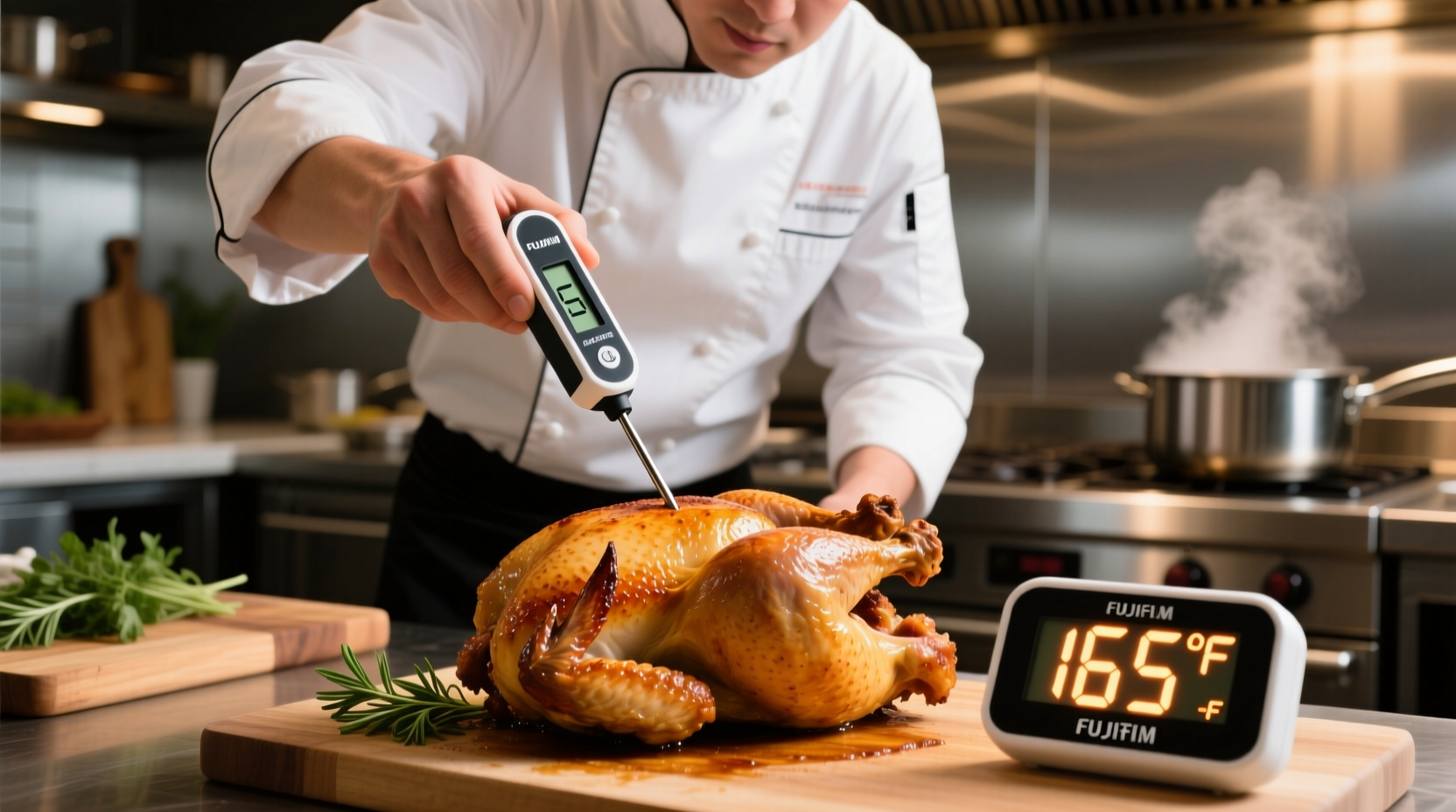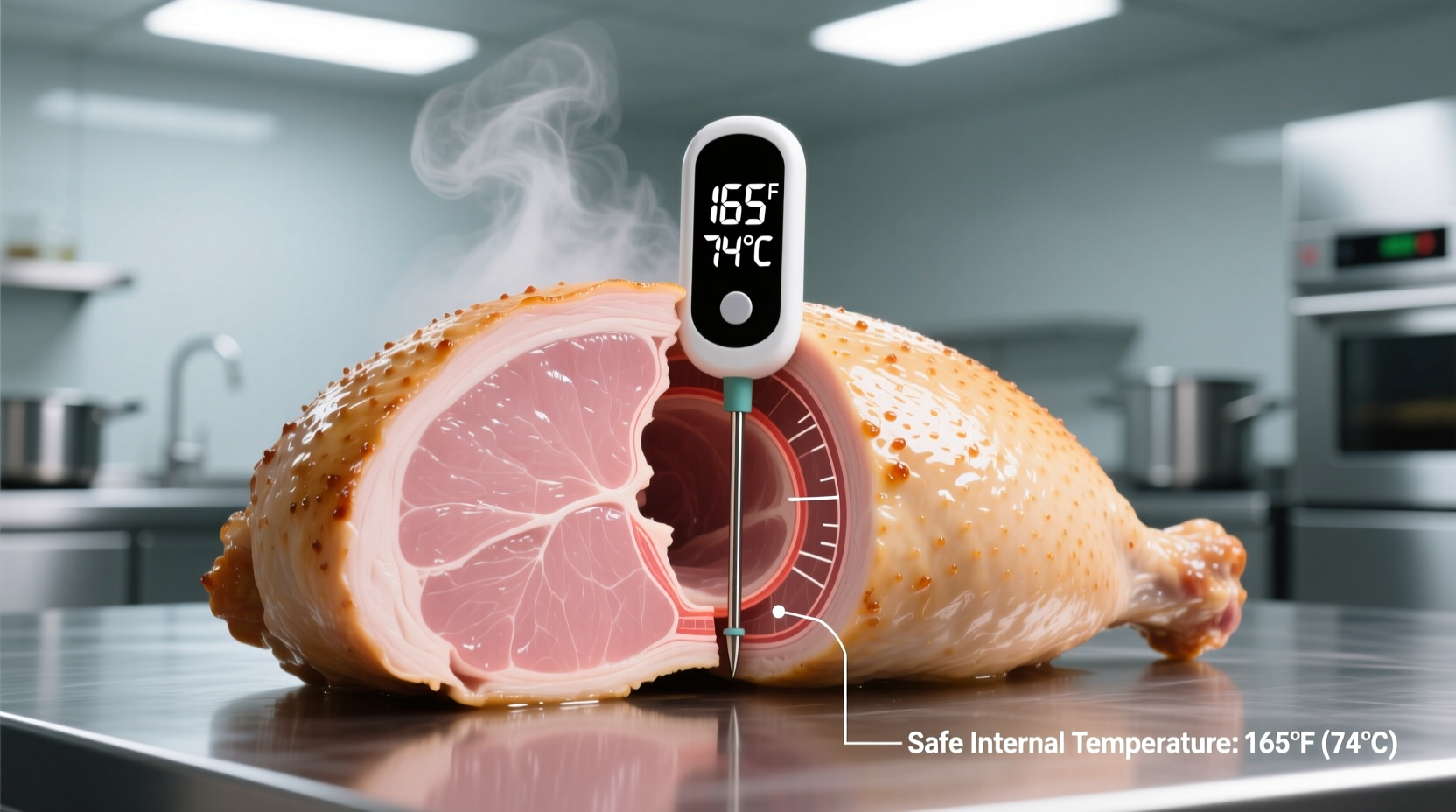When you're preparing chicken for your family, getting the temperature right isn't just about perfect texture—it's a critical food safety requirement. Undercooked poultry ranks among the top causes of foodborne illness in home kitchens, with the CDC estimating millions of annual cases linked to improper poultry handling. This guide provides science-backed temperature guidelines you can trust, complete with practical measurement techniques used by professional chefs.
Why 165°F Is Non-Negotiable for Chicken Safety
The 165°F standard established by the USDA isn't arbitrary—it represents the precise temperature where dangerous pathogens in poultry are instantly eliminated. Unlike beef or pork, chicken's structure allows bacteria to penetrate deeper into the meat, making surface cooking insufficient. When chicken reaches 165°F throughout, you achieve what food scientists call a "lethal combination" of time and temperature that destroys:
- Salmonella (responsible for 1.35 million U.S. illnesses yearly)
- Campylobacter (the leading cause of bacterial diarrhea)
- Listeria monocytogenes (particularly dangerous for pregnant women)
Unlike some meats where lower temperatures are acceptable with extended cooking times, chicken requires this specific minimum internal temperature regardless of cooking method or cut. This safety threshold applies whether you're grilling chicken breasts, roasting a whole bird, or cooking ground poultry.
Proper Temperature Measurement: Avoiding Critical Errors
Over 40% of home cooks rely on visual cues like color or juice clarity to determine doneness—a practice the FDA explicitly warns against. Here's how professional chefs verify chicken temperature accurately:
- Use the right thermometer: Digital instant-read thermometers (like ThermoWorks models) provide accuracy within ±0.5°F
- Target the thickest area: Insert probe into the densest part of meat, avoiding bones or fat pockets
- Check multiple spots: For whole chickens or bone-in pieces, verify temperature in several locations
- Wait for stabilization: Hold thermometer in place until reading stops changing (about 10 seconds)

Chicken Temperature Reference Guide
| Chicken Type | Minimum Safe Temp | Recommended Rest Time | Visual Indicators (Secondary Check) |
|---|---|---|---|
| Boneless breasts | 165°F (73.8°C) | 3-5 minutes | No pink color, juices run clear |
| Bone-in pieces | 165°F (73.8°C) | 5-8 minutes | Meat pulls from bone easily |
| Ground chicken | 165°F (73.8°C) | 2-3 minutes | No pink streaks, firm texture |
| Whole chicken | 165°F (73.8°C) | 10-15 minutes | Legs move freely in joints |
Temperature Troubleshooting: Common Scenarios
"My chicken looks done but hasn't reached 165°F"
This visual-temp disconnect happens frequently with certain cooking methods. The USDA confirms that color alone cannot reliably indicate safety. Continue cooking until the thermometer confirms 165°F, even if the meat appears white throughout.
"I pulled my chicken at 160°F—can I let it rest to 165°F?"
Unlike beef, chicken doesn't experience significant carryover cooking. The temperature rise during resting typically ranges only 2-5°F—insufficient to reach the safety threshold from below 163°F. Always verify 165°F before removing from heat.
"Why does my thermometer show different readings in different spots?"
This indicates uneven cooking—common when using high-heat methods like grilling. Return the chicken to heat and retest after 2-3 minutes. For whole birds, check both breast and thigh areas, as dark meat requires slightly longer cooking.
Avoiding Dangerous Temperature Myths
Despite persistent misconceptions, no reputable food safety organization recognizes lower temperatures for chicken. The FDA Food Code, USDA guidelines, and international food safety bodies all maintain 165°F as the universal standard. Some European countries previously allowed 158°F for certain preparations, but updated their standards to 165°F after WHO reports linked lower temperatures to increased salmonella outbreaks.
When cooking for vulnerable populations—children under 5, adults over 65, pregnant women, or immunocompromised individuals—strict adherence to 165°F becomes even more critical. These groups face significantly higher risks of hospitalization from foodborne pathogens.
Practical Temperature Verification Checklist
Before serving chicken, complete this safety verification:
- Calibrate your thermometer in ice water (should read 32°F/0°C)
- Insert probe into thickest section, avoiding bone
- Verify reading in multiple locations for larger cuts
- Confirm 165°F before removing from heat source
- Clean thermometer probe with hot soapy water after each use
Remember that proper temperature is just one component of chicken safety. Always follow comprehensive food handling practices: prevent cross-contamination, refrigerate promptly, and never thaw poultry at room temperature. When in doubt about doneness, cook to 165°F—it's the only method validated by food safety researchers to eliminate pathogen risk.
Can chicken be safe at 160 degrees Fahrenheit?
No, chicken must reach 165°F throughout to be safe. At 160°F, salmonella requires over 12 minutes to be destroyed—time not achieved during typical cooking. The USDA maintains 165°F as the only safe minimum temperature regardless of cooking method.
How long should chicken rest after reaching 165 degrees?
Boneless chicken needs 3-5 minutes resting time, while bone-in pieces require 5-8 minutes. Resting allows juices to redistribute without significant temperature drop. Never use resting time to reach 165°F—the chicken must already be at temperature before removing from heat.
Does chicken continue cooking while resting?
Chicken experiences minimal carryover cooking (typically 2-5°F) during resting, unlike beef which can rise 5-10°F. This small increase is insufficient to reach safe temperatures from below 163°F. Always verify 165°F before removing chicken from the heat source.
What temperature kills salmonella in chicken instantly?
Salmonella is destroyed instantly at 165°F (73.8°C). At lower temperatures, significantly longer holding times are required (e.g., 150°F requires 3 minutes, 140°F requires 35 minutes), which isn't practical in home cooking. The USDA standard of 165°F ensures immediate pathogen elimination.











 浙公网安备
33010002000092号
浙公网安备
33010002000092号 浙B2-20120091-4
浙B2-20120091-4